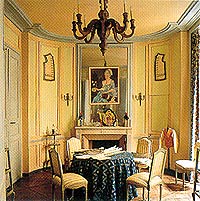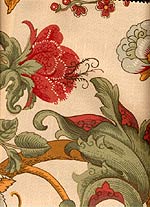The Georgian style is all about symmetry - proportion, scale, volume, AND SIZE. |
Intro 1 / Period Style 2 / Georgian History 3 / Shape 4 / Materials 5 / Structure 6 / Color 7 / Texture 8 / Size |
The
design is directly derived from the classic architectural principles.
First from the Roman Vitruvius, then interpreted by Palladio,
and revived by architects Inigo Jones, Christopher Wren, Colen
Campbell, William Kent, and Robert Adams. The hallmark of the
classical style is the central block (rigid symmetry, center
hall axis), which requires significant size to achieve the balance
or unity of the design. 
So, everything got bigger when the stylistic changes shifted from Baroque to Georgian. Compared to dwellings built just a few years before this style became fashionable, the Georgian style appears enormous in relative scale. As the size increased so did the numbers and sizes of the windows. More light and bigger rooms offered an opportunity to enterprising architects and the emerging profession of interior designers. As this style evolved (and changed into Neoclassicism), we find some remarkable interiors that answered the architectural design demands. (Next issue we take a look at the famous furniture designs of Adam, Chippendale, Sheraton and Hepplewhite. Subscribe Now)
When
looking at Georgian style interiors, look at the architectural
elements that dominate the living spaces-large fireplaces, huge
staircases, grand entrances, and balanced proportioned rectilinear
rooms. The appropriate textiles and wall coverings need to be
of large patterns and scale to achieve a balance with the size
of the elements. (Think of  how
silly a small patterned fabric would look on a massive window
with huge moldings.) Larger pieces of furniture are proportionate
to this space size; however, elegant groupings of smaller chairs
and tables bring about a good visual balance.
how
silly a small patterned fabric would look on a massive window
with huge moldings.) Larger pieces of furniture are proportionate
to this space size; however, elegant groupings of smaller chairs
and tables bring about a good visual balance.
To get an idea of how the Georgian style has been interpreted across the world you might visit Winterthur Museum, The Metropolitan Museum of Art and Victoria & Albert museums period rooms (or their bookstores on line!) But make sure that you go to places where you can see the style first hand. Looking at a whole design in context reveals and explains so much!
Take a trip to Annapolis and see the fabulous examples of the elegant Georgian style. Looking at a city from a design perspective opens up new challenges and directions in the practice of interior design. Learning about what determines and forms a decorative style is useful in understanding how to create a living space. As with every decorative style, artists, designers and historians vary widely in opinion, and make it difficult to find a strict interpretation. However, this is what is fun about learning and applying a decorative style. In the end YOU get to choose what will work for you in your own spaces!
There
are many wonderful books written on The Georgian style and period
design. Look at our Reading (and
bibliography) section for more information, or contact me at
tera@designintuit for
even more information.
Previous / Intro /
1 / 2 / 3 /
4 / 5 / 6 / 7 / 8
Subscribe to our free and extremely informational newsletter. We would love to have your comments at: mail@designintuit.com
Welcome / What We're About / Focus on Annapolis / Marco Polo's Quest / Michelangelo's Den / Great Sites & Sources / Reading / Tiles & Textures / Tools & Terms / Contact Us
This site design and text © DesignIntuit, 2001